The Benefits of TADS in Orthodontics
Orthodontic treatment has evolved over the years, and one of the most significant advancements is the introduction of TADs in the late 1990s. Temporary Anchorage Devices (TADs) are small titanium screws used to provide an extra anchor point in orthodontic treatment. This extra anchor will help to move teeth with greater precision and control. They offer a fixed and immovable point to hold onto and are an essential part of many orthodontic treatments.
In this page, we will discuss the role of TADs in orthodontics, how they assist in teeth and jaw movement, their application, and their benefits. We will also address the issue of discomfort associated with TADs and provide tips on how to care for them. By the end of this article, you'll have a deeper understanding of TADs' importance in achieving optimal orthodontic results.
Understanding the role of TADs in Orthodontics
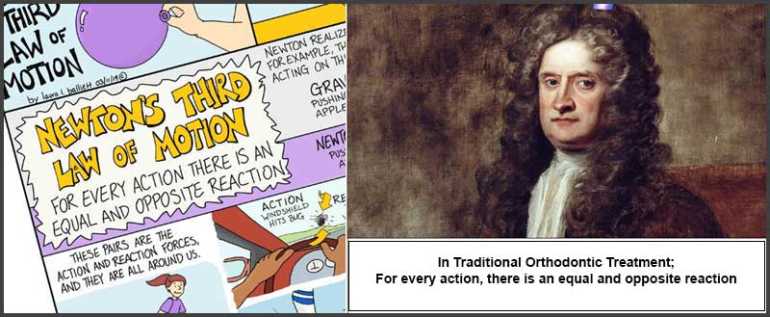
Tooth movements in orthodontics follow the same laws of physics including Newton's 3rd law. This reaction will result -in many times- in unwanted teeth movement requiring extra treatment time and the use of additional forces like rubber bands and headgear.
To counteract the effect of the unwanted reaction, TADs were introduced to absorb the reaction forces by transferring them to the bone.
These small, biocompatible devices serve as anchorage points, allowing for more effective and precise control over the movement of teeth (REF). One of the significant benefits of TADs is that they can minimize the need for headgear, rubber bands, or other external appliances, making the treatment process more comfortable for patients. TADs can be used in combination with braces or other orthodontic appliances to achieve optimal results. Their use allows orthodontists to address complex tooth movements, such as the movement of back teeth or the correction of bite issues, without the need for jaw surgery or dental implants.
What are TADs?
TADs, or Temporary Anchorage Devices, are small titanium screws placed in the jawbone as anchor points during orthodontic treatment with high success rate (REF). They are usually 1.5 mm in diameter with 6-8 mm in Length. This small diameter makes it easy to be placed between the teeth in both the upper and lower jawbone. TADs are biocompatible and cause no discomfort. Dr. Kanaan is using TADs in conjunction with braces, Invisalign, Lingual Braces, and other orthodontic appliances.
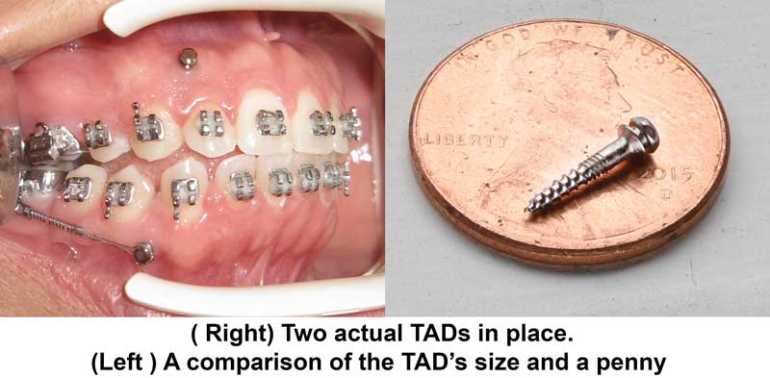
The concept of Anchorage in Orthodontics
During orthodontic treatment, anchorage plays a crucial role in directing the tooth movement in the desired direction. Anchorage refers to the use of fixed points to stabilize teeth, preventing unwanted shifts. In the past, orthodontists used certain appliances to add more anchorage such as the Nance Appliance, the Transpalatal Arch TPA, the headgear, and more. Temporary Anchorage Devices (TADs), such as mini-screws or dental implants, provide reliable anchorage and enhance treatment outcomes. By serving as anchorage points, TADs allow for precise control over tooth movement and minimize the need for external appliances like headgear. TADs not only provide additional support but also maintain orthodontic anchorage throughout the treatment process.
Dr. Kanaan, A top Houston TADs / Mini Implant Specialist
Dr. Kanaan was certified to place TADs and mini implants by IMTEC in 2004. Since then, he has placed over 2200 TADs in Houston to help patients get their teeth and bites corrected. Dr. Kanaan has placed TADs made by IOS, 3m unitek, ORMCO and OrthoTechnology. He preferred the double-thread TADs from IOS for their superior stability.
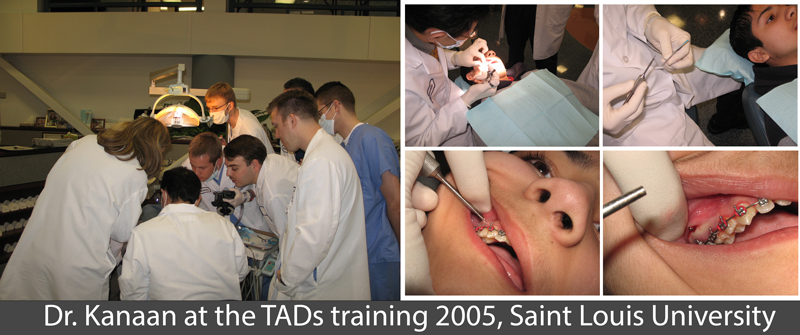
The Application and Benefits of TADs in Orthodontics
TADs, could be used in a wide variety of different cases ranging from easy to complex ones (REF). I will present here some case that we treated successfully at iSmile specialists using TADs:
1. Severe overbite correction. This patient was referred to Dr. Kanaan to get her severe overbite corrected. She has over 11 mm of overbite and the lower teeth were touching the roof of her upper jaw. Dr. Kanaan placed 2x TADs in her upper jaw and got her overbite corrected. Please notice the lip enhancement and balance. Total treatment time 26 months
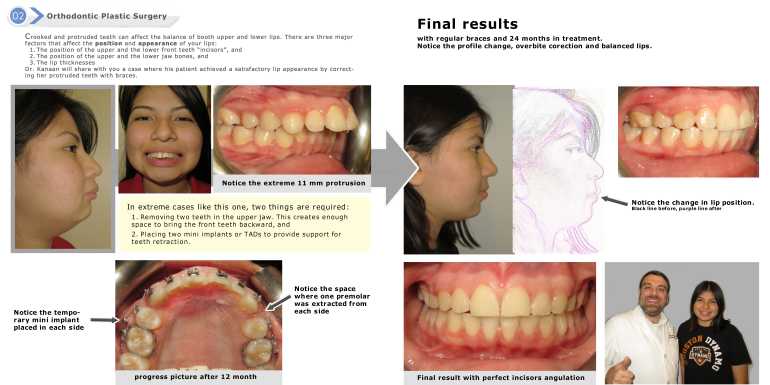
2. Underbite correction without Surgery. TADs can play an essential role in preventing patients of getting jaw surgeries to correct their underbite. Using the same principle of mountain climbing, we can push the lower teeth back using TADs placed in the wisdom teeth area. Please enjoy this case done in Houston with TADs!
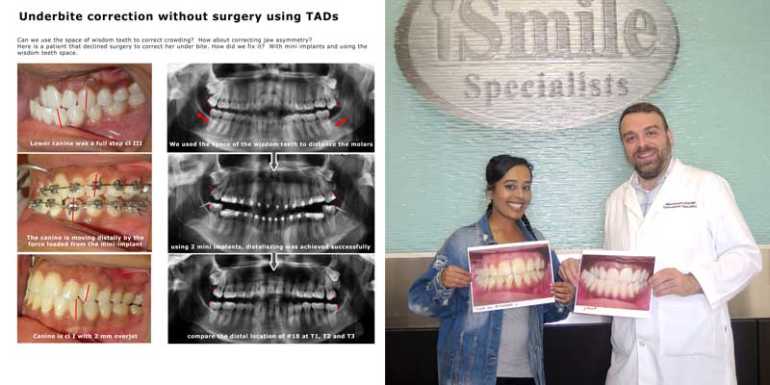
3. Open bite correction. This patient was not able to talk or swallow correctly for 28 years and she was afraid of doing the jaw surgery. Dr. Kanaan presented her with the option of correcting her open bite without jaw surgery using 2x mini implants. The case was completed in 29 months with excellent results.
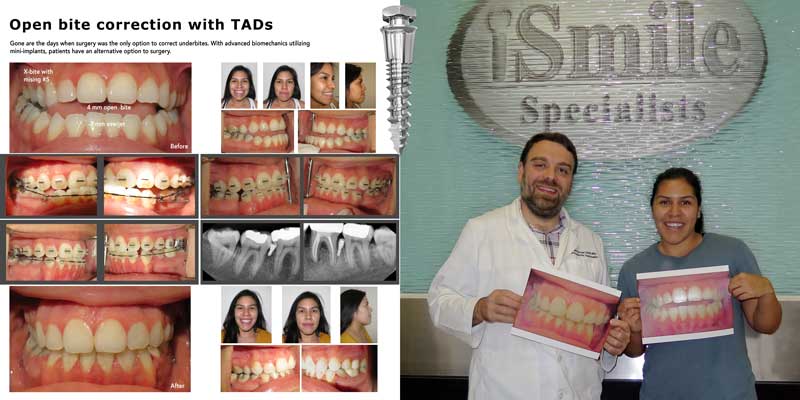
4. Closing the space of a missing tooth. If you are getting orthodontic treatment and you don't want to get a bridge or an implant to replace a missing tooth, then TADs might help you to get the space close. By combining the usage of TADs and special biomechanics, Dr. Kanaan was able to close this space and save the patient the cost of getting an implant.
5. Intruding super-erupted teeth. When teeth are missing for a long time, the opposing teeth tend to move toward the missing teeth. This movement will encroach on the space of the opposing teeth and make the future replacement almost impossible.
6. Correcting tilted teeth. Posterior tilted teeth pose a challenge to correct because of the angulation and location. TADs can help to provide the correct direction of force to upright the tilted tooth. Here is a case treated by Dr. Kanaan with TADs in Houston to correct the lower second molars. Case took 25 months to finish with excellent results.
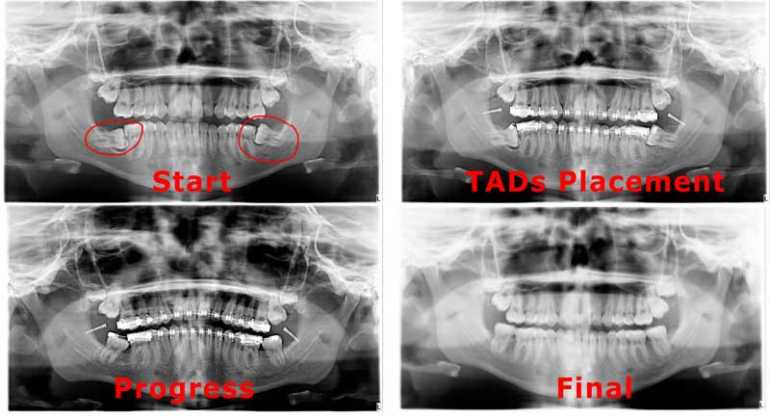
7. Correcting Impacted teeth. TADs will help to correct the wrong-growing tooth and bring it back to its proper position. Impacted canines can be challenging to move due to their location, but TADs assist in overcoming this hurdle. Here is a case where Dr. Kanaan placed a TAD on the upper right side to correct the impacted canine. After the impacted tooth was corrected, braces were placed and the teeth got straight.
8. MARPE / MSE application. The addition of 2 or 4 TADs to the palatal expander revolutionized the upper jaw expansion into more stable and aggressive results.
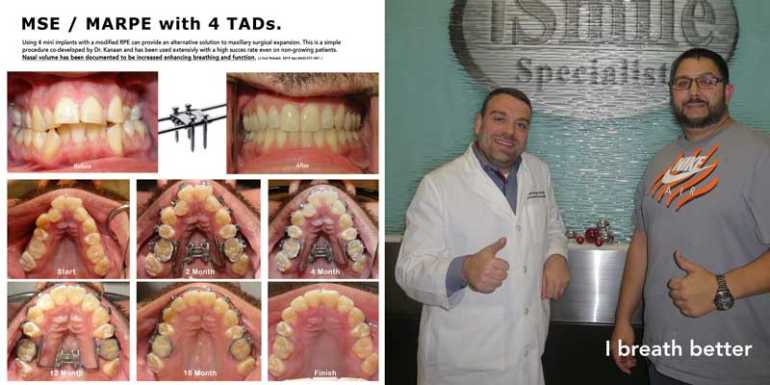
Another advantage of TADs is their compatibility with orthognathic surgery. These mini screws can be used in conjunction with orthognathic surgery to provide comprehensive treatment for patients. This combination allows for more precise and efficient orthodontic care. TADs serve as anchorage points during the surgical procedure, ensuring stable and successful results. Overall, TADs offer a versatile and effective solution in orthodontics, empowering dentists to achieve optimal outcomes for their patients.
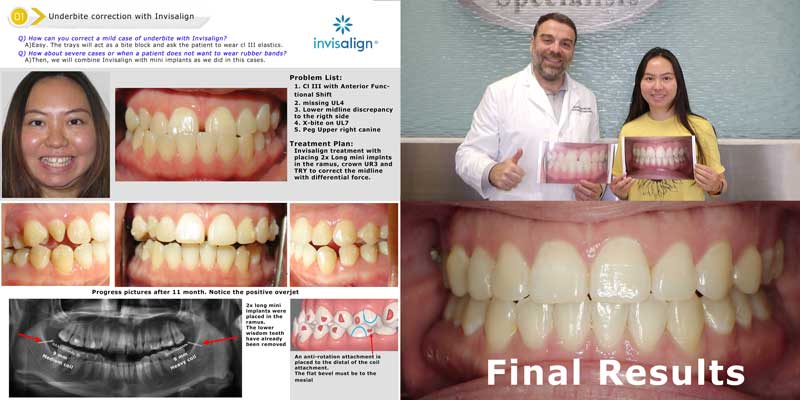
TADs and the issue of Discomfort: What you need to know
TAD placement is minimally invasive and Dr. Kanaan developed a technique to place the TAD in 2 minutes or less. His non-invasive technique will cause little to no discomfort, which is usually temporary. If any discomfort is experienced, it can easily be managed with over-the-counter pain relievers. One of the reasons TADs are comfortable is their small diameter, reducing irritation to surrounding gum tissue. Additionally, TADs are biocompatible devices that integrate well with the jawbone and gums, ensuring optimal comfort for patients.
Maintenance and Care for TADs
Proper maintenance and care are crucial when it comes to TADs in orthodontics. These devices typically remain implanted throughout the duration of orthodontic treatment. Keeping TADs clean is essential, and this can be achieved by gently brushing them with a soft toothbrush. However, it's important to avoid using an electric toothbrush directly on TADs as this may cause damage. Regular check-ups with your orthodontist are also vital to monitor the condition of the TADs and ensure their effectiveness. If any issues arise, such as discomfort or movement of the TADs, it's essential to contact your orthodontist for further guidance. By following these maintenance and care practices, you can ensure the success of your orthodontic treatment.
How long do TADs typically stay implanted, and how can they be maintained?
TADs are typically implanted for several months to a few years during orthodontic treatment. To maintain them, it's crucial to practice good oral hygiene by regularly brushing and flossing, being careful around the TAD area. Avoiding hard or sticky foods is also important to prevent dislodgement. If any concerns arise, contact your orthodontist promptly (REF).
Conclusion
To summarize, TADs (Temporary Anchorage Devices) have revolutionized the field of orthodontics by providing additional support and stability during the teeth straightening process. These small, temporary implants play a crucial role in achieving precise and efficient tooth movement, especially in complex cases. The benefits of TADs include reduced treatment time, improved treatment outcomes, and minimized discomfort for patients. It is essential to follow proper maintenance and care guidelines for TADs to ensure their longevity and effectiveness. Regular check-ups with your orthodontist will help monitor the progress and make any necessary adjustments. If you are considering orthodontic treatment, ask your orthodontist about the potential benefits of incorporating TADs into your treatment plan.




